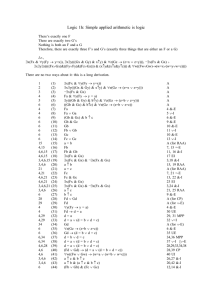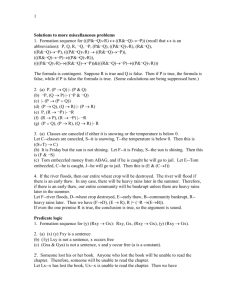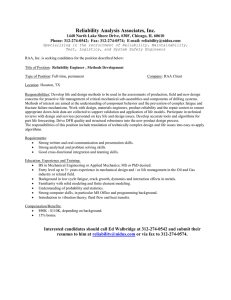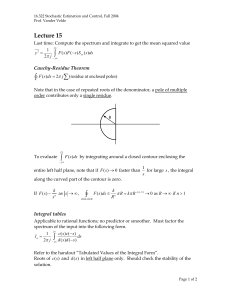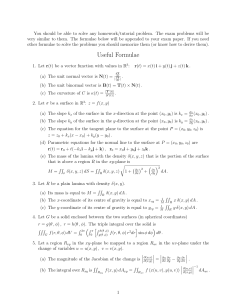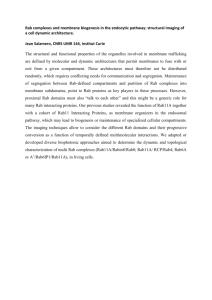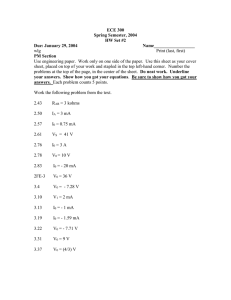Practice Final Exam — Key PHI 201
advertisement
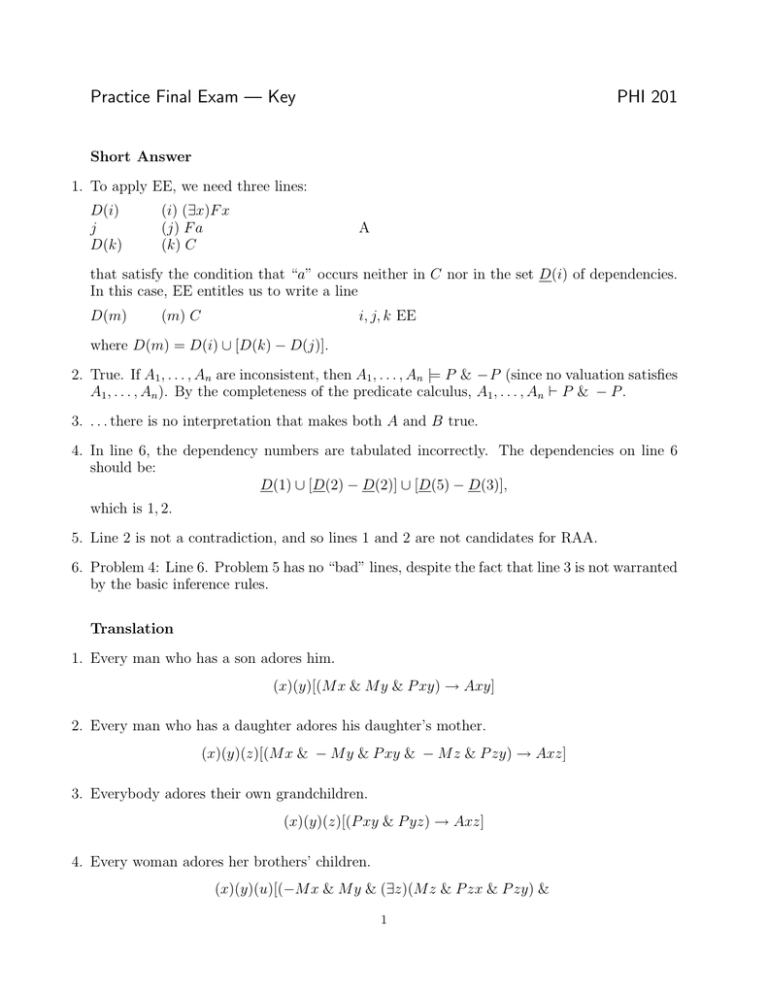
Practice Final Exam — Key PHI 201 Short Answer 1. To apply EE, we need three lines: D(i) j D(k) (i) (∃x)F x (j) F a (k) C A that satisfy the condition that “a” occurs neither in C nor in the set D(i) of dependencies. In this case, EE entitles us to write a line D(m) (m) C i, j, k EE where D(m) = D(i) ∪ [D(k) − D(j)]. 2. True. If A1 , . . . , An are inconsistent, then A1 , . . . , An |= P & −P (since no valuation satisfies A1 , . . . , An ). By the completeness of the predicate calculus, A1 , . . . , An ` P & − P . 3. . . . there is no interpretation that makes both A and B true. 4. In line 6, the dependency numbers are tabulated incorrectly. The dependencies on line 6 should be: D(1) ∪ [D(2) − D(2)] ∪ [D(5) − D(3)], which is 1, 2. 5. Line 2 is not a contradiction, and so lines 1 and 2 are not candidates for RAA. 6. Problem 4: Line 6. Problem 5 has no “bad” lines, despite the fact that line 3 is not warranted by the basic inference rules. Translation 1. Every man who has a son adores him. (x)(y)[(M x & M y & P xy) → Axy] 2. Every man who has a daughter adores his daughter’s mother. (x)(y)(z)[(M x & − M y & P xy & − M z & P zy) → Axz] 3. Everybody adores their own grandchildren. (x)(y)(z)[(P xy & P yz) → Axz] 4. Every woman adores her brothers’ children. (x)(y)(u)[(−M x & M y & (∃z)(M z & P zx & P zy) & 1 (∃w)(−M w & P wx & P wy)) → (P yu → Axu)] 5. No man adores children unless he has his own. (x)[(M x & − (∃z)P xz) → (y)((∃t)P ty → −Axy)] 6. Someone has at most three children. (∃x)(y)(z)(t)(w)[(P xy & P xz & P xt & P xw) → (Iyz ∨ Iyw ∨ Iyt ∨ Izw ∨ Izt ∨ Iwt)] Proofs and Counterexamples 1. Prove the following tautology using only basic rules of inference: ` −(P → Q) ↔ (P & − Q) 1 2 1 1,2 1 1,2 1 9 10 11 12 11,12 10,11,12 10,11 10,11 10 9,10 9 9 (1) P & − Q (2) P → Q (3) P (4) Q (5) −Q (6) Q & − Q (7) −(P → Q) (8) (P & − Q) → −(P → Q) (9) −(P → Q) (10) −(P & − Q) (11) P (12) −Q (13) P & − Q (14) (P & − Q) & − (P & − Q) (15) − − Q (16) Q (17) P → Q (18) −(P → Q) & (P → Q) (19) − − (P & − Q) (20) (P & − Q) (21) −(P → Q) → (P & − Q) (22) (−(P → Q) → (P & − Q)) & ((P & − Q) → −(P → Q)) (23) −(P → Q) ↔ (P & − Q) A A 1 &E 2,3 MPP 1 &E 4,5 &I 2,6 RAA 1,8 CP A A A A 11,12 &I 10,13 &I 12,14 RAA 15 DN 11,16 CP 9,17 &I 10,18 RAA 19 DN 9,20 CP 8,21 &I 22 Dfn↔ 2. Prove the validity of the following argument using only basic rules of inference. (∃x)(F x & (y)(Gy → Rxy)), (x)(F x → (y)(Hy → −Rxy)) ` (x)(Gx → −Hx) 2 1 2 3 3 2 2,3 3 2,3 3 10 3,10 3,10 2,3,10 2,3 2,3 1,2 (1) (∃x)(F x & (y)(Gy → Rxy)) (2) (x)(F x → (y)(Hy → −Rxy)) (3) F a & (y)(Gy → Ray) (4) F a (5) F a → (y)(Hy → −Ray) (6) (y)(Hy → −Ray) (7) (y)(Gy → Ray) (8) Hb → −Rab (9) Gb → Rab (10) Gb (11) Rab (12) − − Rab (13) −Hb (14) Gb → −Hb (15) (x)(Gx → −Hx) (16) (x)(Gx → −Hx) A A A 3 &E 2 UE 4,5 MPP 3 &E 6 UE 7 UE A 9,10 MPP 11 DN 8,12 MTT 10,13 CP 14 UI 1,3,15 EE 3
